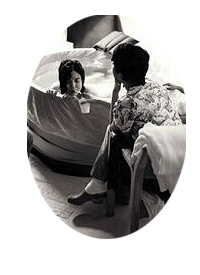By Judith Halek
 |
Women In Photography debuts an photographs
and an article on photographing water labors and births in the No.
8, Fall Issue, October 1, 2001 Issue. The following is a rendition
of the article written by Judith Halek that appeared in this issue.
To view the full issue at Women in Photography, click
here.
|
Documenting births has been an obsession of mine since 1987, when I assisted the first homebirth, waterbirth, in New York City. Over the past fourteen years I have slipped in and out of one of the most intimate experiences known to life. I've had the privilege of documenting in three separate environments; homes, hospitals and birth centers. My specialty is underwater birth. Waterbirth
takes place when the baby is actually born from the womb of
water inside the mother, to an extended womb of water, which
could be a bathtub, a portable birthing pool, a jacuzzi, a
water trough, or an ocean.
I work with the available light. Because of its invasive nature, I rarely use a strobe. I find available lighting creates a truer, softer, journalistic reflection. I work with the fastest film for the camera: Ilford and T-Max 400 and 800 for black and white and Fuji color (I find the skin tones are truer with Fuji). Sometimes I'll be creative and shoot 1600 and 3200 when I'm at a home where candles are the only light source. I then utilize a monopod. |
I
take anywhere between 5-8 rolls of film. I participate quietly
in the labor and birth dance by making myself as inconspicuous
as possible and shoot further away rather than close up. I work
with the Canon EOS, SLR system; two cameras at a time with the
Canon Elf as a third back up if we are transferring to the hospital
or birth center. I use a EF 50mm f1:4 and EF 70-200 f1.2.8 lenses.
I advise taking along a wide-angle lens such as a
21mm or 28mm for the confined areas. When shooting, it is important to focus on the details. Focus on becoming a Zen photographer and capture tender moments of father comforting mother, a gentle touch on a belly, a reflection in a mirror, a flower floating in water. If
you are fortunate enough to be invited into the OR in a hospital,
you'll wear their sterile gowns. Pay attention to where you
can and cannot be, and don't touch anything! Take a small
fanny pack for your film. In a birth center you can wear comfortable
clothing to move around in, climb on top of tables, beds,
chairs, or edges of the tub. A home birth environment is the
most relaxed. Wear clean clothes, shoes that slip on and off
easily, take time to use the bathroom, eat and hydrate yourself
with something other than caffeine. Judith Halek is the director of Birth Balance, the east coast resource center for under water birth. Judith is now in the process of moving her 15 years of photography out to the public. She has been published in numerous birth journals such as Midwifery Today, The Journal of Perinatal Education an ASPO/LAMAZE Publication as well as New York Magazine. She will be debuting her first solo show at a prestigious birth center in New York City this winter. *Judith Halek is among the photographers of WIPI's 20th Anniversary International Tea Time exhibit |





